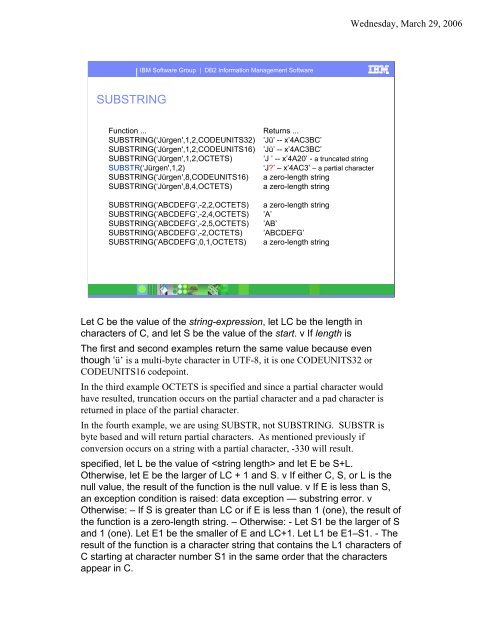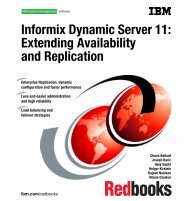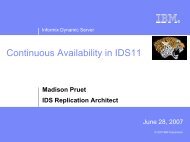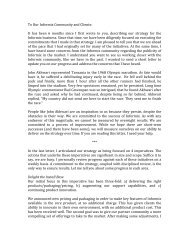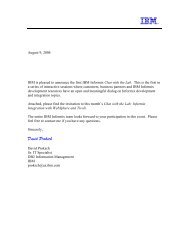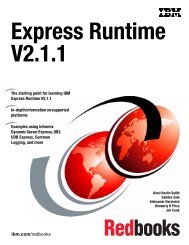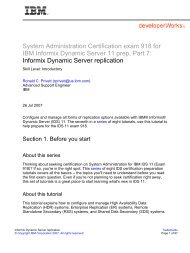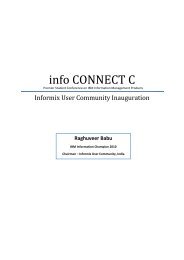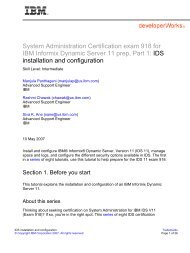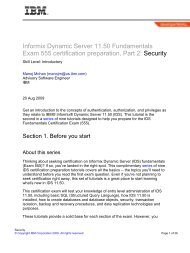CCSID 102 â What's a CCSID and why do I care?
CCSID 102 â What's a CCSID and why do I care?
CCSID 102 â What's a CCSID and why do I care?
Create successful ePaper yourself
Turn your PDF publications into a flip-book with our unique Google optimized e-Paper software.
Wednesday, March 29, 2006<br />
IBM Software Group | DB2 Information Management Software<br />
SUBSTRING<br />
Function ... Returns ...<br />
SUBSTRING(‘Jürgen',1,2,CODEUNITS32) ’Jü’ -- x’4AC3BC’<br />
SUBSTRING(‘Jürgen',1,2,CODEUNITS16) ’Jü’ -- x’4AC3BC’<br />
SUBSTRING(‘Jürgen',1,2,OCTETS) ’J ’ -- x’4A20’ - a truncated string<br />
SUBSTR(‘Jürgen',1,2)<br />
‘J?’ –x’4AC3’– a partial character<br />
SUBSTRING(‘Jürgen',8,CODEUNITS16) a zero-length string<br />
SUBSTRING(‘Jürgen',8,4,OCTETS) a zero-length string<br />
SUBSTRING(’ABCDEFG’,-2,2,OCTETS)<br />
SUBSTRING(’ABCDEFG’,-2,4,OCTETS)<br />
SUBSTRING(’ABCDEFG’,-2,5,OCTETS)<br />
SUBSTRING(’ABCDEFG’,-2,OCTETS)<br />
SUBSTRING(’ABCDEFG’,0,1,OCTETS)<br />
a zero-length string<br />
’A’<br />
’AB’<br />
’ABCDEFG’<br />
a zero-length string<br />
Let C be the value of the string-expression, let LC be the length in<br />
characters of C, <strong>and</strong> let S be the value of the start. v If length is<br />
The first <strong>and</strong> second examples return the same value because even<br />
though ‘ü’ is a multi-byte character in UTF-8, it is one CODEUNITS32 or<br />
CODEUNITS16 codepoint.<br />
In the third example OCTETS is specified <strong>and</strong> since a partial character would<br />
have resulted, truncation occurs on the partial character <strong>and</strong> a pad character is<br />
returned in place of the partial character.<br />
In the fourth example, we are using SUBSTR, not SUBSTRING. SUBSTR is<br />
byte based <strong>and</strong> will return partial characters. As mentioned previously if<br />
conversion occurs on a string with a partial character, -330 will result.<br />
specified, let L be the value of <strong>and</strong> let E be S+L.<br />
Otherwise, let E be the larger of LC + 1 <strong>and</strong> S. v If either C, S, or L is the<br />
null value, the result of the function is the null value. v If E is less than S,<br />
an exception condition is raised: data exception — substring error. v<br />
Otherwise: – If S is greater than LC or if E is less than 1 (one), the result of<br />
the function is a zero-length string. – Otherwise: - Let S1 be the larger of S<br />
<strong>and</strong> 1 (one). Let E1 be the smaller of E <strong>and</strong> LC+1. Let L1 be E1–S1. - The<br />
result of the function is a character string that contains the L1 characters of<br />
C starting at character number S1 in the same order that the characters<br />
appear in C.


